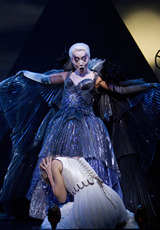| Opera Reviews | 25 April 2024 |
An exuberant Magic Fluteby Catriona Graham |
|
| Mozart: Die Zauberflöte Scottish Opera Edinburgh Festival Theatre November 2012 |
|
|
The costumes are a delight - all steampunk corsets and frock-coats with toppers. And they change in Mark Jonathan's stunning lighting. The Three Ladies' amazing headdresses shine as one crescent moon and two constellations respectively, given the right light, while the lining of the Queen's cloak is not seen in all its shades of grey until the enlightenment of the finale and curtain calls. The machinery of the stage also displays its full golden glory only in the bright light of the end. In Simon Higlett's design, two segments of a circle, each with three tiers of gallery above the levers, gears and flywheels, first appear half-way through the overture. Till then, we have seen a jolly painted proscenium arch with masonic and other symbols, through which an equally jolly showman appears and summons a man from the dress circle box. The details are such fun. Monostatos's soldiers start morris dancing when Papageno plays his bells at them. Pamina reclines on a red velvet chaise longue whose legs are high-heeled boots. And egg-shaped baby carriages for the future Papageni. For once, the Tamino / Pamina pairing is robust enough to make us care that they make it through their trials. Laura Mitchell's Pamina is no wilting flower but a lively, engaging young woman. Nor is Nicky Spence a pious prig as Tamino, but gives as good as he gets in exchanges with Papageno. From the stylised moustachio'd showman of the overture, to being slightly stoned after a hookah comes down in response to his request for a glass of wine, Richard Burkhard's Papageno is ebullient. The libretto helps - in a sparkling and very twenty-first century translation by Kit Hesketh-Harvey. Ruth Jenkins has a voice like a saw as the old woman, mercifully discontinued when she reveals herself as Papagena. The Three Boys - spookily dressed from head to toe in white - not only descend on wires, twirling brollies, from on high but are also the only characters in eighteenth century dress, with powdered hair. Monostatos is more a cad than evil, which makes it more believable that Papageno scares him from assaulting Pamina. Peter Van Hulle is outraged astonishment, as his plans are ever thwarted. Jonathan Best is suitably solemn and, generally, impassive as Sarastro. As Speaker, Nicholas Lester is patient in his explanations both to the men's chorus and to Tamino and Papageno. The standard, of singing is high, not least Mari Moriya's vocal gymnastics as the Queen of the Night though occasionally Spence's top notes and Best's lowest notes could be stronger. Although one feels sure that Mozart's music plays itself, the orchestra is conducted by Ekhart Wycik, on his debut with Scottish Opera. And what of the trials? Fire is portrayed by boilermen stoking furnaces under the galleries, water by steam gushing over the lovers from a large pipe. Then with enlightenment all round, the women reappear in peplum'd grey coats over black britches, being admitted to equality with men. Hm! |
|
| Text ©
Catriona Graham Photo © Ken Dundas |

 Rarely
have I coveted a cloak as much as that worn by the Queen of the Night
in Scottish Opera's new production of The Magic Flute, exuberantly
directed by Sir Thomas Allen.
Rarely
have I coveted a cloak as much as that worn by the Queen of the Night
in Scottish Opera's new production of The Magic Flute, exuberantly
directed by Sir Thomas Allen. 





